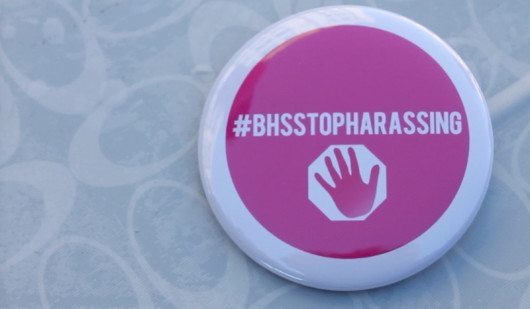Location: Berkeley, CA

Berkeley High School students wearing their BHS Stop Harassing t-shirts, 2014. (photo courtesy of BHS Stop Harassing).
I. WOMEN SPEAKING OUT
IN THE BEGINNING OF THE 2014-2015 school year, all students at Berkeley High School in Berkeley, California attended a welcome assembly. This is the only assembly that every student is required to attend, and because the student population is around 3,600 students there needed to be six assemblies that day. Towards the end of the assembly, our Dean of Students was asked to speak on our ‘dress code’ and sexual harassment. There is no dress code at Berkeley High. However, the Dean thought it was appropriate to blame a culture of sexual harassment at Berkeley High on the clothing choices of the female students. He then proceeded to briefly define sexual harassment, and tell us that if we ever felt harassed, we should speak with him for support. He repeated this presentation throughout the day at all six assemblies, and it wasn’t until 6th period that a female high school senior spoke up in protest.
About a week later, our friend Liana Thomason invited us to a meeting to talk about our feelings regarding the welcome assembly. When we arrived at the meeting, there were about eight women, students and parents, sitting around a table eating pizza. The meeting quickly turned into an animated discussion about all of the experiences we’ve had with sexual harassment at Berkeley High, with specific criticism towards how it was addressed in the welcome assembly. What each of us quickly realized was that we weren’t alone in our feelings; we were all offended by the uninformed, insensitive, sexist comments made by our Dean of Students. One gathering lead to another, and we began meeting weekly. We talked with more and more female students about their experiences with both sexual harassment and the assembly, and we began to research our rights as female citizens. We also looked into Title IX, the federal law that states: No person in the United States shall, on the basis of sex, be excluded from participation in, be denied the benefits of, or be subjected to discrimination under any educational program or activity receiving federal financial assistance. About a month into our weekly meetings, we established ourselves as Berkeley High School Stop Harassing, BHS Stop Harassing for short.
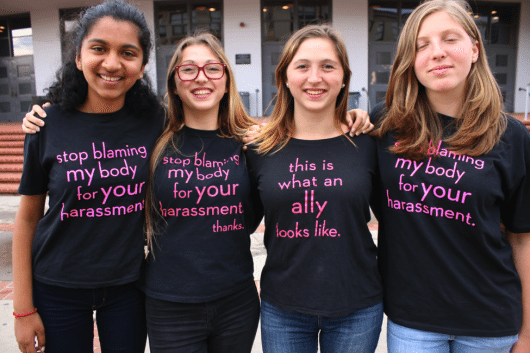
BHS Stop Harassing steering committee members (left to right): Uma, Maya, Rachel, Emily, 2015 (photo courtesy of BHS Stop Harassing).
II. COMING TOGETHER TO ORGANIZE
THROUGHOUT THE YEAR WE organized and participated in multiple events to bring awareness to the community and to spread our message. We started a gofundme account to raise money for events we had planned and we’re going to plan in the future. The first major event we organized was a ‘teachout’ on sexual harassment, which included multiple booths set up across the street from the Berkeley High School campus on Allston way at Civic Center Park. Our primary goal for the ‘teachout’ was to educate our peers on what sexual harassment is, and how to identify and prevent it. We also wrote a petition to the school board, asking for a change in the district’s policy, and collected over 700 signatures of teachers, students and community members. During our teachout we also designed and distributed free t-shirts with the message ‘stop blaming my body for your harassment’ and ‘this is what an ally looks like.’ Our booths were surrounded by students holding gigantic posters with facts and statistics about sexual harassment and assault along with quotes from inspirational women. Our second action came a week later. Upon handing someone a shirt, we asked them to wear it the following week, for Blackout Day. On this day, we asked all members of the Berkeley High community to wear their pins and shirts, to provide a visual representation of how many people are affected by sexual harassment, and to encourage our school and the District to do something about it.
After we collected all the signatures for the petition, we decided it was time to present them to the school board. We spoke with members of the school board, and they agreed to give us an eight minute slot to speak during the public comment section of the meeting. We spread the world through social media, word of mouth, and classroom announcements encouraging both students and faculty to attend the meeting to show their support. During the presentation, many brave young woman shared their personal stories of sexual harassment and assault with the school board and the people attending it. We encouraged the school board to consider our stories, listen to our complaints, and create a change to the district’s policy. Those who came to the meeting to support us wore their BHS Stop Harassing shirts and pins. We brought our posters and had members surround the room holding them for everyone to read.
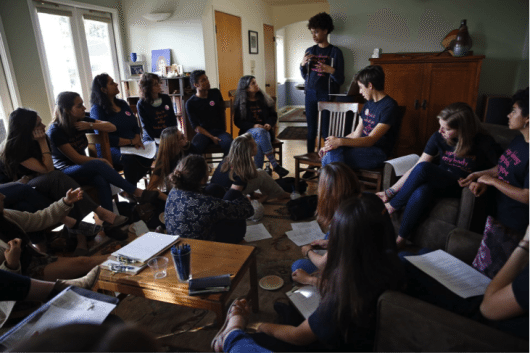
BHS Stop Harassing Sunday afternoon meeting to elect the first Steering Committee, Winter 2014. (photo by Scott Strazzante for Sf Chronicle article).
III. INCORPORATING ART INTO ORGANIZING
TWO OF OUR MOST SUCCESSFUL campaigns were our poster campaigns. In our very first one, we covered the school with two thousand posters with facts and statistics regarding gender inequality and sexual harassment. It was visual, and easily accessible to the audience we were intending to reach, making it incredibly successful. Our second poster campaign was equally successful. This one included information about the Office of Civil Rights investigation taking place at Berkeley High, and how students can let their voices be heard. The success of these two campaigns can be largely attributed to the power of words and graphic art in our creative expression. Art, including language, is one of the most influential and powerful ways to spread a message, and it makes our movement that much stronger.
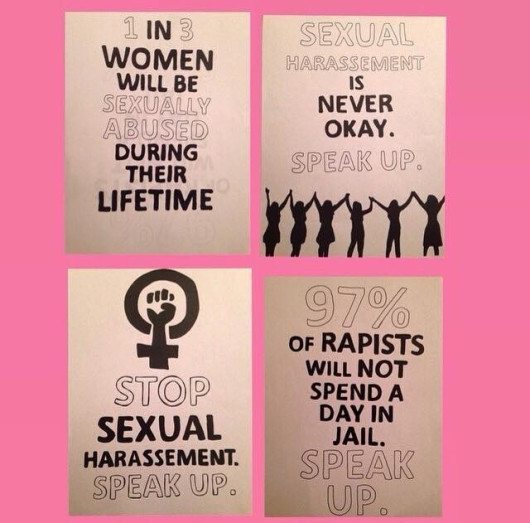
Posters designed by BHS students Emma Moriconi and Maya Buffet-Davis (photo courtesy of BHS Stop Harassing).
IV. SOCIAL JUSTICE AND CREATING SAFER SPACES
OUR MOTIVATION FOR STARTING this organization is deeply rooted in our connection to social justice. We want to create positive change for women and girls in society, making school a safer place. School should be a place where students learn about the do’s and don’ts of sexual harassment from a young age, and are brought up with the knowledge needed to prevent harassment and assault that are so prevalent in schools today. Because this culture of harassment is so deeply ingrained in society, it will take much more than a group of youth to change it. However, we have made a start by speaking to the press, spreading our stories, spreading facts and raising awareness in our school and the community. We have also created a website so people all over the country can read about our goals and join our movement.
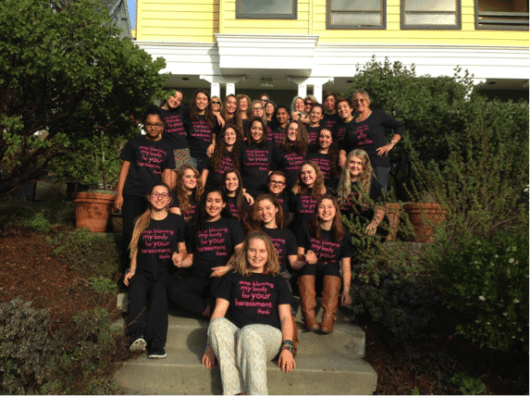
After BHS Stop Harassing planning meeting for the November Teach-Out, members modeling new t-shirts that they will give away at the event, funded by a successful GoFundMe campaign, 2014-(photo courtesy of BHS Stop Harassing).
This past June, the members of BHS Stop Harassing received the Champion of Justice Award from Equal Right’s Advocates (ERA). This award is given to a woman, or a group of women whose actions are helping to build a more equitable future for women and girls. BHS Stop Harassing was the first youth group to ever receive this award. Continuing our work into this school year we have begun to direct our work more towards education. Our mission for this year is to expand the membership of our organization and to greatly increase and improve what students are learning about harassment inside the classroom. We plan to write comprehensive curriculum, using both our experiences as high schoolers, in addition to curriculum written by Futures Without Violence, to help us educate our classmates.
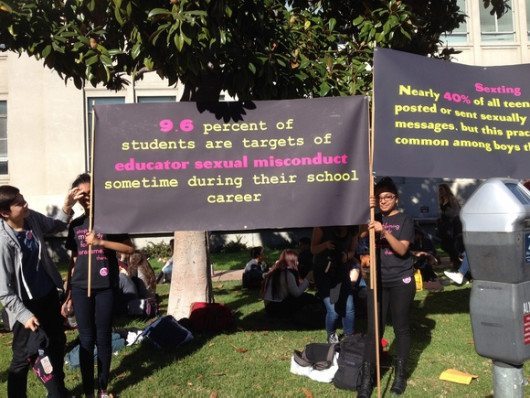
BHS Stop Harassing members Uma and Jaya as human billboards at the November 2014 Teach-Out-(photo courtesy of BHS Stop Harassing).
Through our art and media campaigns, we have begun to tell our story and encourage others to join our movement. Now, we are over a year old, and will remain an organization for as long as sexual harassment is present in our society.

